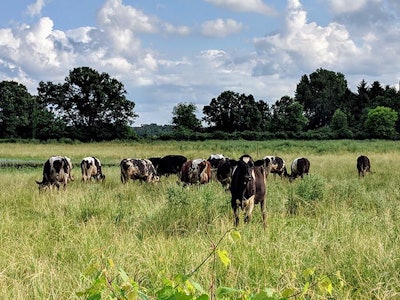
For producers that raise livestock on pasture, grazing is the most economical means of harvesting forage. But summer heat, drought and over-grazing can render lush, green pastures thin and bare, leaving both the pasture and the livestock nutrient deficient.
If your pasture looks bare in the summer months, it’s time to rethink how you are grazing your animals, said Kent Solberg, a livestock and grazing specialist with the Sustainable Farming Association (SFA). Solberg offered the following five strategies to manage grazing during the “summer slump,” which he presented during a webinar hosted by the Food Animal Concerns Trust (FACT) on May 30.
1. Managed rotational grazing
The first thing to consider to make it through the summer slump is to move toward managed rotational grazing, or flex grazing. In this system of grazing, herds or flocks are regularly and systematically moved to fresh, rested pasture to maximize the quality and quantity of forage growth. Resting pastures, instead of continuous grazing, allows the vegetation to renew its energy reserves and deepen root systems, resulting in higher forage production and utilization, less soil erosion and increased soil fertility. Solberg stated that when a long-enough rest period is built into the grazing system, producers are stockpiling forages that can buy up to a month of extra grazing to get through the summer months.
“We get the best bang for our buck and the most stock-piling of forage opportunity when our post-grazing stubble height is fairly high, when our grazing period is relatively short, and we have a long recovery period,” stated Solberg. With a continuous grazing period with no recovery, there is damage to the base and the root of the plant, which results in the reduced ability of the plant to recover and handle drought.
One thing to note, stated Solberg, is that this rest period is based on grass recovery, not the calendar. “It’s tempting, easy, and simple to [base it on the calendar], but the grass doesn’t work that way.” The point is to use rotation to better utilize the forage in a pasture without overgrazing; the animals need to be moved based on recovery versus the calendar or a set number of paddocks.
If producers want more feed next year, trample more forage this year. “Graze the best. Trample the rest,” stated Solberg. “Many of us were raised thinking that it’s waste if the animals don’t graze it, but most of the nutrition is in the upper third of the forage plants. When we trample some of the less nutritious stuff, we leave leaf area to capture light for photosynthesis, we don’t do damage to the root, and we provide protection to the soil to minimize erosion and protect soil health to grow future forage.”
2. Harvest spring surplus
Another option for the summer slump is to harvest the spring surplus of hay/haylage to use another time of the year. “Hay is really a tool,” said Solberg. “In livestock agriculture we think, ‘Well, we’ve got to have hay for the winter season.’ But hay is a tool to use when we need to fill in gaps in our forage production.” Some producers choose to hay a portion of accessible pasture acreage in late spring, typically about 30 to 60 percent. And usually these sites can be grazed again in about 45 to 80 days, in the mid to late summer, depending on the weather and rainfall.
When using this strategy, Solberg encourages producers to think about rotating which paddocks are being cut and which ones are being grazed, and then feeding that hay back out on the paddock it was cut to return those nutrients back to the soil.
3. Reduce livestock population
Another strategy for the summer months is to reduce the livestock population. For example, a producer with a grass-fed beef operation may want to target harvesting animals before the summer season. Solberg has worked with producers that use bi-seasonal calving, where they place their dry cows on a different pasture in July and August before they freshen in September and October.
An additional option is to wean early — when calves are weaned early, the nutritional demands of the cows drops dramatically, with a 30 percent reduction in feed consumption, taking pressure off the pasture.
4. Aim for as much forage diversity as possible
The greater the variety of perennial forage sward or stand in your pastures, the better the nutrition and the chance that it will last through the summer and growing season, helping diversify your herd or flock’s diet without significantly increasing costs. This can be accomplished by inter-seeding mid- or warm-season perennials like red clover, alfalfa, intermediate wheatgrass, endophyte-free tall fescue, chicory and switchgrass. For producers looking for a place to start, Solberg recommends utilizing the Natural Resources Conservation Service (NRCS) or the local extension for plants that are applicable to your region. The cheap, low-cost way to do this, said Solberg, is with a no-till drill. Some producers in the Midwest and Northern states have had luck with frost seeding by stressing the sward in the fall.
Solberg also recommends utilizing warm-season perennial paddocks, or if farming in the South, looking for cool-season opportunities. This can help stretch out rest periods for the cool-season pastures, especially when the productivity of cool-season perennial grasses wanes during heat of summer.
Seeded annuals, known as cover crops, are also great ways to use crop ground to broaden the rotation. These summer annuals are often drought-resistant, and because of their rapid growth, they can outcompete weed species. There are both single cut (grazing corn, forage sorghum) and multi-cut (sudangrass, pearl millet, teff) species. The multi-cut species, with good management, can regrow and be grazed several times. Solberg encourages the use of multi-species.
“This can be a powerful way to build your forage chain, to take more of the severe climate situations, like a drought,” said Solberg. Solberg gave an example of a pasture in North Dakota that was seeded the last week of June with 29 cover crop species. In August, after receiving only half an inch of rain and summer temperatures nearing 100 F, the complex cover crop pasture appeared drought-stressed but was still green and providing forage with a height to the backs of adult angus cattle. “There was a lot of feed there, and a lot of opportunity to give cool-season pastures a break,” said Solberg.
Solberg defines a complex cover crop mix as having at least three grasses (for example, oat, sudangrass, pearl millet, corn or barely), three legumes (cowpea, crimson clover, sunn hemp, field pea) and three broadleaves (sunflower, buckwheat, safflower, purple top turnip), with a minimum of nine species total in the mix. If nine species are intimidating, or for anyone who is new to designing a cover crop mix, Solberg recommends the SmartMix cover crop calculator, a free online tool from Green Cover Seed.
5. Feeding stored forages
Solberg encourages producers to think about systematically and strategically feeding the hay back out on a site that needs some work. For example, take a dry or drouthy hilltop, and with some polywire and step-in posts, a “sacrifice paddock” can be created. Solberg noted that he doesn’t like the term sacrifice paddock and thinks they should instead be called opportunity paddocks, because when producers feed this way, there is an opportunity to use the hay feeding to build fertility on these sites. Solberg said he has a site just like this on his own farm, and over the course of a few weeks, he strategically fed on this site to protect his other pastures. Now he has the best grass growing in this pasture in the last 15 years because of the extra fertility added.
Producers considering this strategy should consider part-time hay feeding, said Solberg. Instead of the animals being on pasture 24 hours a day, they are instead on pasture for 10, 12 or 16 hours a day and given hay at night. This creates a great opportunity to not only stretch out the pasture resource but to do some management on the poorer performing sites.

















